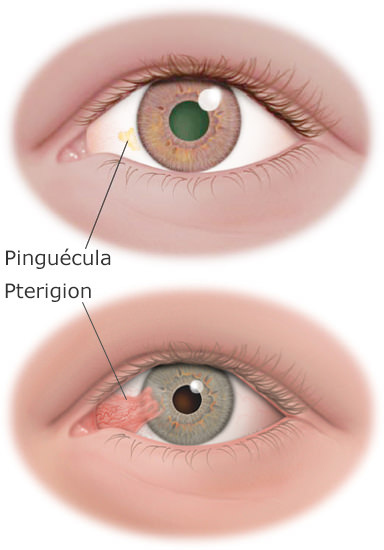

Pinguecula and pterygium are growths on your eye’s conjunctiva, the clear covering over the white part of the eye.
Pinguecula is a growth that looks like a yellow spot or bump on the conjunctiva. It often appears on the side of the eye near your nose. A pinguecula is a deposit of protein, fat, or calcium.
Pterygium is a growth of fleshy tissue that may start as a pinguecula. It can remain small or grow large enough to cover part of the cornea. When this happens, it can affect your vision.
Both pinguecula and pterygium are believed to be caused by a combination of dry eyes and exposure to wind, dust, and ultraviolet (UV) light from the sun.
lf you have had a pinguecula or a pterygium at least once before, try to avoid the things that cause these growths. Here are some ways:

• wear sunglasses to protect your eyes from ultraviolet (UV) light.
• protect your eyes from dust by wearing glasses or goggles.
• use artificial tears when your eyes are dry.
Symptoms of pinguecula and pterygium can range from mild to severe. They include:
• redness and swelling of the conjunctiva, mostly while the pterygium grows.
• a yellow spot or bump on the white of your eye.
• dry, itchy, burning eyes. Or feeling like sand or grit is stuck in your eye.
• blurry vision.
In many cases pinguecula and pterygium do not need to be treated. However, if your eyes are uncomfortable or your vision is affected, you may need treatment.
Drops to lubricate your eyes can help relieve dry eye irritation from pinguecula. They also help relieve that annoying feeling as if you have something in your eye. If pinguecula causes redness and swelling in your eye, your doctor may prescribe steroid eye drops.
Usually eye drops can relieve any discomfort from pinguecula, and surgery is usually not recommended or needed.
Your ophthalmologist can treat the discomfort, redness or swelling from a pterygium with lubricating or steroid eye drops.
If a pterygium grows large enough to cause problems, your ophthalmologist will probably recommend surgery to remove it. Once the pterygium is removed, your surgeon may transplant a thin piece of normal tissue onto the affected area. This technique helps reduce the chance that your pterygium will grow back.
The best way to keep pinguecula and pterygium from coming back is to avoid dryness, sunlight and dust.
Source.aao